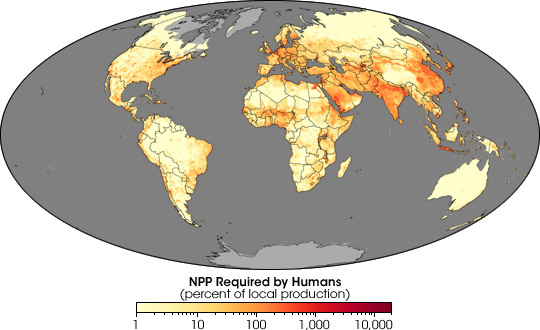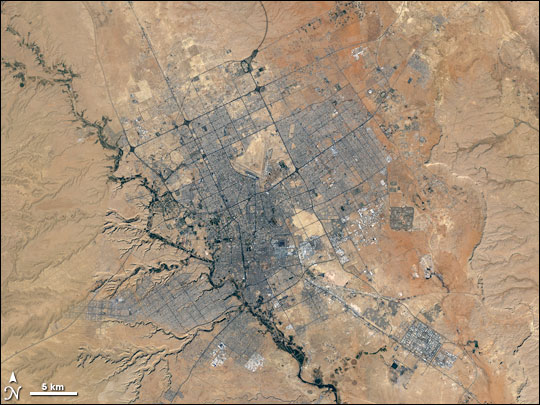

Keeping up with Demand | |||
When he compared the global supply of net primary production to the human appetite, Imhoff confirmed some ideas that did not surprise him. “Some things were a no-brainer,” he said. “For example, urban populations with a high density consume way more primary production than local ecosystems can produce.” One sharp example of this was New York City, which consumed 30,000 percent more primary production than it created. “That says a lot about the dependence of urban areas on our transportation networks and agricultural infrastructure,” he said. The ratio of consumption to regional net primary productivity might prove to be a useful indicator of potential trouble spots should natural disasters, economic insecurity, or other problems undermine networks or infrastructure. |
|||
 | |||
|
Having enough food may seem like a concern only for developing countries, but industrialized countries also have concerns about food security, which is defined simply as always having enough food for an active, healthy life. Developed countries may have dense urban populations, import more food, and be accustomed to high levels of consumption—all of which make these countries susceptible to transitory food supply disruptions. In addition, developed countries may have poor populations that are vulnerable to rising food prices in spite of typical governmental support services. Imhoff said, “Worldwide, we have some very vulnerable populations that could never survive just on the productivity of the land on which they live—with some important implications for national and regional food security.” Closely tied to the question of having enough food for survival is the idea of having enough fuel, clothing, and building materials for survival. The availability of everything from firewood to winter coats begins with plants. Consumption of material goods is an important factor in economic stability and security, as well as in maintaining or improving lifestyle levels. The more a population consumes, the more effort it takes to maintain that standard of consumption. Imhoff found that there were two big factors that lead to high consumption levels. The first is high per-capita consumption rates, as seen in much of the developed world; the second is large populations. Even a low per-capita consumption rate can result in a huge overall level of total consumption if multiplied over a large number of people. |
In many areas, human consumption far exceeds what the land in the immediate vicinity can provide. Densely populated countries, such as India and China, often consume more than 100 percent of locally available net primary production (NPP), but so do smaller countries in areas with naturally low NPP, such as Saudi Arabia. Even in productive areas like the eastern United States and Europe, demand exceeds local supply due to high levels of per-person consumption. (Image by Jesse Allen, based on data from NASA’s Socioeconomic Data Center.) | ||
 | |||
|
To Imhoff, a more surprising finding was the importance of technology in helping balance the equation between supply and consumption. “We found that using improved technology—especially in harvesting and storage techniques—can actually halve the amount of waste in agricultural production,” he said. “Take logging. Without the benefits of improved harvesting technology, you might literally lose a tree for every one that you use.” The interplay between population, consumption rates, affluence, and technology leads to some thought-provoking realizations. “For example, Asia’s per-capita consumption is on the rise,” he said. “If consumption begins to match Western levels, there will be a significant increase in demand for food and fiber products. If technology improvements do not come with that growth, then you’ll see populations that are outstripping their regional food production capacity. They’ll be more dependent on resources elsewhere, and will have to compete for them.” Although citizens in industrialized countries may not find the rising population in developing nations of immediate concern, poverty has been connected to terrorism, war, underemployment, border pressures, disease, and political unrest. “It’s a question of how much we are willing to pay to keep getting the level of production that we want, and to transport it from one place to another,” Imhoff said. |
In marginally productive areas, such as the desert landscapes of the Arabian Peninsula where Saudi Arabia's capital, Riyadh, is located, it is easy for human populations to consume far more primary production than the local landscape can supply. Landsat 7 captured this image of Riyadh on December 16, 2000. The urban grid appears gray, isolated patches of vegetation are dark green, and the bare ground surrounding the city is pinkish-tan. Riyadh has a population of more than 4 million residents. (NASA image created by Jesse Allen, using Landsat data provided by the University of Maryland’s Global Land Cover Facility.) | ||